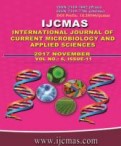


 National Academy of Agricultural Sciences (NAAS)
National Academy of Agricultural Sciences (NAAS)

|
PRINT ISSN : 2319-7692
Online ISSN : 2319-7706 Issues : 12 per year Publisher : Excellent Publishers Email : editorijcmas@gmail.com / submit@ijcmas.com Editor-in-chief: Dr.M.Prakash Index Copernicus ICV 2018: 95.39 NAAS RATING 2020: 5.38 |
The current study reports the occurrence of Clostridium chauvoei in sheep and goats in Kashmir valley. A total of 412 faecal samples were collected from different organized and unorganized sheep and goat farms of the Kashmir valley. The samples consisted of 212 samples from sheep (adult-70, lamb-42) and goats (adult-80, kid-20) without diarrhoea (healthy) and (adult-40, lamb-60) and goats (adult-70, kid-30) with diarrhoea, were enriched in RCM broth before final isolation on blood agar plates. Suspected haemolytic colonies were purified and were identified tentatively as C. chauvoei based on Gram’s staining and morphological characteristics, colony characteristic and biochemical tests. They were finally identified by 16S rRNA gene specific PCR. Out of the 70 adult sheep and 42 lamb samples without diarrhoea, C. chauvoei was obtained from 8(11.42%) and 10(23.8%) samples, respectively. Similarly, 5(12.5%) and 15(25%) samples from 40 adult sheep and 60 lambs with diarrhoea, respectively yielded C chauvoei. Likewise, 1(1.25%) and 2(10%) isolates were recovered from 80and 20 healthy adult goat and kid samples, respectively. The diarrhoeic samples yielded 2(12.5%) and 3(10%) isolates from adult goats and kids, respectively. The overall prevalence of C. chauvoei in sheep and goat was found to be 11.16%. Lambs and kids were found to harbour more Clostridium chauvoei than the adult animals of the corresponding species.
 |
 |
 |
 |
 |